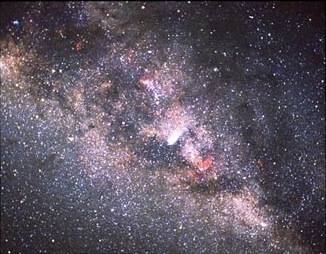|
|
Q 'n A
Answers To Your Questions
SPACE TODAY ONLINE ~~ COVERING SPACE FROM EARTH TO THE EDGE OF THE UNIVERSE
Q. What is the Milky Way? — Lisa P.
A. It is our home galaxy.
While a Milky Way may be a candy bar, the Milky Way is a collection of hundreds of billions of stars traveling through the Universe together like a giant cloud floating across the sky.
Our own star is the Sun. It is just one among the 750 billion to one trillion stars that astronomers say compose the Milky Way galaxy.

In this NASA photo of our Milky Way galaxy, the dark patches in front of the brighter background are opaque clouds of clumped dust grains known as dark nebulae. |
If you think about it, that's a whole lot of stars. To top that, there are untold trillions or quadrillions or quintillions of galaxies beyond our own. Each of those galaxies also is a giant cloud of stars traveling through the Universe. Imagine how many stars there must be across the whole Universe!
Our Milky Way is about 100,000 light years in diameter. Radioastronomy shows it to be a spiral shaped galaxy.
Our galaxy is named Milky Way because it appears to observers as a faintly luminous band of stars stretching across Earth's night sky. The hazy appearance of the Milky Way results from the combined light of of the many stars too far away to be distinguished individually by a naked eye.
Solar systems. Our Solar System is a set of nine planets plus asteroids and comets surrounding our star, the Sun. Most of the hundreds of billions of other stars in the Milky Way may have their own solar systems.
For an individual star of the Milky Way to be seen distinctly in Earth's night sky, it must lie sufficiently close to our Solar System to be discerned separately.
Can we see the Milky Way? On a night that seems especially dark outside, go someplace far from outdoor lighting. Look up into the sky for a faint, hazy, whitish band of starlight that spans the heavens. That band will be the Milky Way galaxy.
You may notice that the Milky Way looks splotchy — darker regions interspersed with lighter regions. The dark patches in front of the brighter background are opaque clouds of clumped dust grains known as dark nebulae.
All of the stars that we can see belong to the Milky Way and we only can see a tiny fraction of our Milky Way. Altogether, we can distinguish only about 2,000 individual stars. However, on a dark night, you can see clusters of stars and galaxies and get an idea of the Milky Way's vastness.
Through a small pair of binoculars you can see that the Milky Way is composed of many distant stars packed so tightly together that they seem to be almost touching one another.
Giant Frisbee. The Milky Way is a flattened spiral galaxy that spins. You might imagine it flying through space like a giant Frisbee at a speed of more than a million miles an hour.
The Milky Way revolves once every 225 million years. That means it takes our Sun and its Solar System 225 million years to travel all the way around the center of the galaxy.
A ray of light takes 100,000 years to cross the galaxy. That means the Milky Way is 100,000 lightyears across. Its thickness at the bulging center of the galactic disk is 1,000 lightyears. Our Solar System lies about two-thirds of the way out from the center of the galaxy.
At the heart of the Milky Way. Astronomers believe they see an extraordinarily powerful object — a black hole — at the center of the Milky Way.
Learn more:
 Ask Space Today Online another question Ask Space Today Online another question
 Return to the Questions 'n Answers main page Return to the Questions 'n Answers main page
|

 Ask Space Today Online another question
Ask Space Today Online another question